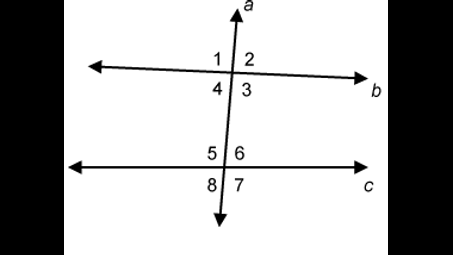What else can I help you with?
Which of the following describes the relationship between angle 8 and angle 7?
A+
What describes the angle between level ground and the edge of a pyramid?
An Obtuse Angle (Apex)
What is the relationship between the tangents of complementary angles?
The tangent of an angle equals the inverse of an angle complementary to it. The relationship between the two tangents is that they are multiplicative inverses.
What is the relationship between latitude and the angle of the sun's rays?
They both have to do with whether or not people get sunlight or if they don't.
What is the relationship between the measure of a central angle of a polygon and the measures of an interior and an exterior angle of the polygon?
The interior angle and central angle are supplementary, that is they always add up to 180 degrees, while the exterior angle and the central angle will always be the same.
Which of the following describes the relationship between angle 8 and angle 7?
A+
Which of the following describes the relationship between angle 4 and angle 5?
consecutive angles
Which of the following describes the angle between water level and the incline of a water ski ramp?
Acute angle
Which of the following describes the angles between level ground and the edge of a pyramid?
A obtuse angle Apex:3
The relationship between the angle of incidence and the angle of refraction is known as law?
Snell's Law describes the relationship between the angle of incidence and the angle of refraction for light passing through different mediums. It states that the ratio of the sine of the angle of incidence to the sine of the angle of refraction is constant for a given pair of media.
What describes the angle between a wall and an open door?
an obtuse angle
Does the relationship between the angle of incidence and the angle of reflection change as the angle of incidence increases?
No, the relationship between the angle of incidence and the angle of reflection remains the same regardless of the angle of incidence. This relationship is governed by the law of reflection, which states that the angle of incidence is equal to the angle of reflection.
What is the relationship between the fof angle and the angle of of2?
The relationship between the fof angle and the angle of of2 is that they are supplementary angles. This means that the sum of the fof angle and the angle of of2 is equal to 180 degrees.
The relationship between the angle of incidence and the angle of refraction is known as law.?
The relationship between the angle of incidence and the angle of refraction is known as Snell's Law. This law states that the ratio of the sine of the angle of incidence to the sine of the angle of refraction is equal to the ratio of the speeds of light in the two different mediums. It describes how light waves change direction when crossing from one medium to another.
What describes the angle between the top and side of an open box?
An obtuse angle
Is perpendicular to a preposition?
No. Perpendicular is an adjective. It cannot be a preposition.
What describes the angle between level ground and the edge of a pyramid?
An Obtuse Angle (Apex)

